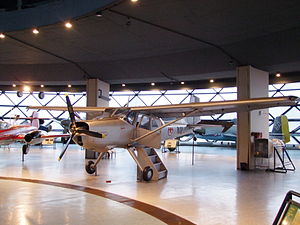This article needs additional citations for verification. (January 2025) |
The UTVA-66, is a STOL light utility / liaison aircraft produced in the former Yugoslavia. A development of the UTVA-56, it first flew in 1966 and was intended largely for use by the Yugoslav military.[1]
| Utva-66 | |
|---|---|

| |
| Utva-66 on display in the Museum of Aviation | |
| Role | Military Training Aircraft/General Aviation Aircraft |
| Manufacturer | UTVA |
| Designer | UTVA |
| First flight | 1966 |
| Status | Retired |
| Number built | 130 |
Description
editThe UTVA-66 derived from the UTVA-56, featuring fixed leading-edge slats and a larger tail.[2]
The aircraft was designed to operate from unprepared fields. Its STOL characteristics include leading edge fixed slats, flaps and drooping ailerons.[3] The cockpit is equipped with dual flight controls. The right front and rear seats in the older version of the aircraft could be removed to accommodate two stretchers.[citation needed] The 66H ("Hidro") variant replaced the fixed landing gear with pontoon floats for operation from bodies of water;[2] these could be exchanged for snow skis.[citation needed]
Operational usage
edit130 UTVA-66 aircraft were manufactured.[citation needed]
During the Yugoslav Wars some aircraft fell into Slovenian and Croatian hands.[2] The last operational aircraft were withdrawn from military service in 1999.[citation needed]
Subsequently, a number were sold to Canada and the United States of America where they were converted for civilian use as rugged utility aircraft.[citation needed]
Variants
edit- 66AM − Air ambulance version.[2]
- 66H − Floatplane version.[2]
- 66V − Armed variant with provisions for underwing armament.[2]
Former military operators
edit- Yugoslav Air Force[2]
- 461st Light Combat Aviation Squadron (1977–1988)[citation needed]
- 462nd Light Combat Aviation Squadron (1977–1981)[citation needed]
- 252nd Fighter-Bomber Aviation Squadron (1981–1992)[citation needed]
- Letalski center Maribor (Civil operator) (1989-2003)[citation needed]
Aircraft on display
edit- Serbia
A number of Utva 66 including Utva 66H are on display. [1]
Specifications (Utva 66)
editData from Jane's All the World's Aircraft 1971–72.[3]
General characteristics
- Crew: 1
- Capacity:
- 3 passengers or
- 2 stretchers
- Length: 8.38 m (27 ft 6 in)
- Wingspan: 11.4 m (37 ft 5 in)
- Height: 3.20 m (10 ft 6 in)
- Wing area: 18.08 m2 (194.6 sq ft)
- Airfoil: NACA 4412 (modified)
- Empty weight: 1,250 kg (2,756 lb)
- Max takeoff weight: 1,814 kg (3,999 lb)
- Fuel capacity: 250 L (55 imp gal; 66 US gal)
- Powerplant: 1 × Lycoming GSO-480-B1J6 air-cooled flat-six engine, 200 kW (270 hp) [4]
Performance
- Maximum speed: 250 km/h (160 mph, 130 kn) at optimum height
- Cruise speed: 230 km/h (140 mph, 120 kn) (max cruise)
- Stall speed: 80 km/h (50 mph, 43 kn)
- Never exceed speed: 320 km/h (200 mph, 170 kn)
- Range: 750 km (470 mi, 400 nmi)
- Service ceiling: 6,700 m (22,000 ft)
- Rate of climb: 4.50 m/s (885 ft/min)
- Takeoff run to 15 m (50 ft): 352 m (1,155 ft)
- Landing run from 15 m (50 ft): 181 m (594 ft)
See also
editAircraft of comparable role, configuration, and era
References
editBibliography
edit- Fulton, Ken (19 July 1973). "Piston Engine Survey". Flight International. Vol. 104, no. 3358. pp. 98–106.
- Rendall, David Alexander, ed. (1996). Jane's Aircraft Recognition Guide. Glasglow: HarperCollins. ISBN 978-0-00-470980-2.
- Taylor, John W. R., ed. (1971). Jane's All The World's Aircraft 1971-72. London: Sampson Low. ISBN 0-354-00094-2.